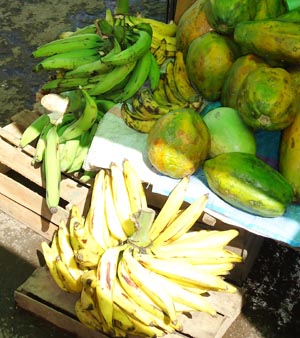Mexican Kitchen

Although grown most frequently in the tropical coastal areas of the country, plantains are found in markets all over Mexico, where they are called plátano macho and look like bananas on growth hormones, ranging in color from bright green and unripe to nearly black and looking overripe.
Like the banana, the plantain is an herbaceous flowering plant, and not a “tree” at all, and its female flowers are the ones that become fruit. While in the same botanical family as bananas, plantains are lower in both moisture and sugar. Unlike bananas, plantains are not eaten raw, and their high starch content means that they are frequently used as a vegetable, especially in the Caribbean, Latin America, and Africa.
In Veracruz, because of its strong Afro-Caribbean culinary roots, plantains are used to make dough for empanadas and for delicious black-bean filled croquettes, as well as a variety of fritters. And all over Mexico, fried plantains are served over white rice in a typical sopa seca (“dry soup”) comida course. Fried plantains are also a common dessert food, sold in the street at night from carts and at virtually every fair or carnival, drizzled with sweetened condensed milk, and sometimes gilding the lily with chocolate sprinkles or powdered chocolate.
In Central and Southern Mexico, especially in Puebla and Oaxaca, plantains are an integral part of the mole known as manchamanteles, or “tablecloth stainer.” This dish can be made with different fruits, according to the region and season, but always contains plantains. In Oaxaca, plantains are added with pineapple to a spicy-sweet lentil stew, and in Chiapas they are used in a hearty vegetable soup.
In coastal regions, where plantains are important in the diet, they are used green, yellow, or black. They are often bought green at the market and left to ripen to the various stages need for different dishes — green for fritters, yellow for fried plantains served with rice, fish, or as dessert, and black for use as a dough.
Plantains are high in dietary fiber and a good source of potassium and vitamins A and C. They are available all over Mexico, in Latino markets north of the border, and in many large supermarkets.
They are especially good for grilling, and if you live someplace where summer means outdoor grilling, try wrapping a couple of unpeeled, ripe plantains in aluminum foil and putting them on the grill with whatever else is being cooked. They’ll take about 20 minutes, and can just be peeled and eaten as a side dish, or as the meal’s dessert.
As a side, plantains go particularly well with grilled chicken or fish, and as dessert, plantains need nothing more than a topping of whipped cream, ice cream, honey, or the sweetened condensed milk added with a flourish by the street vendor. They can also be foil-wrapped and baked in a 400°F oven for about 20 minutes. When frying plantains, peel them before slicing diagonally and cooking in hot vegetable oil.
When buying plantains, choose green ones if using them shredded in coastal-style fritters. Otherwise, yellow ones with some black spots are fine for baking, frying or grilling. If using plantains to make a dough, let them ripen until almost completely black. Wrapping in newspaper hastens ripening.
Following are some recipes using this versatile ingredient that can be served in every course from soup to dessert.
- Yucatan style plantain soup: Sopa de plátano yucateca
- Crunchy Mexican Plantain Fritters: Aranitas
- Mexican plantain empanadas with picadillo: Empanadas de plátano
- Mexican filled plantain croquettes: Croquetas de plátano rellenos
- Mashed Mexican plantains with pork rinds: Machuca de plátano con chicharrones
- Mexican plantains with vanilla cream: Postre de plátanos con vainilla

